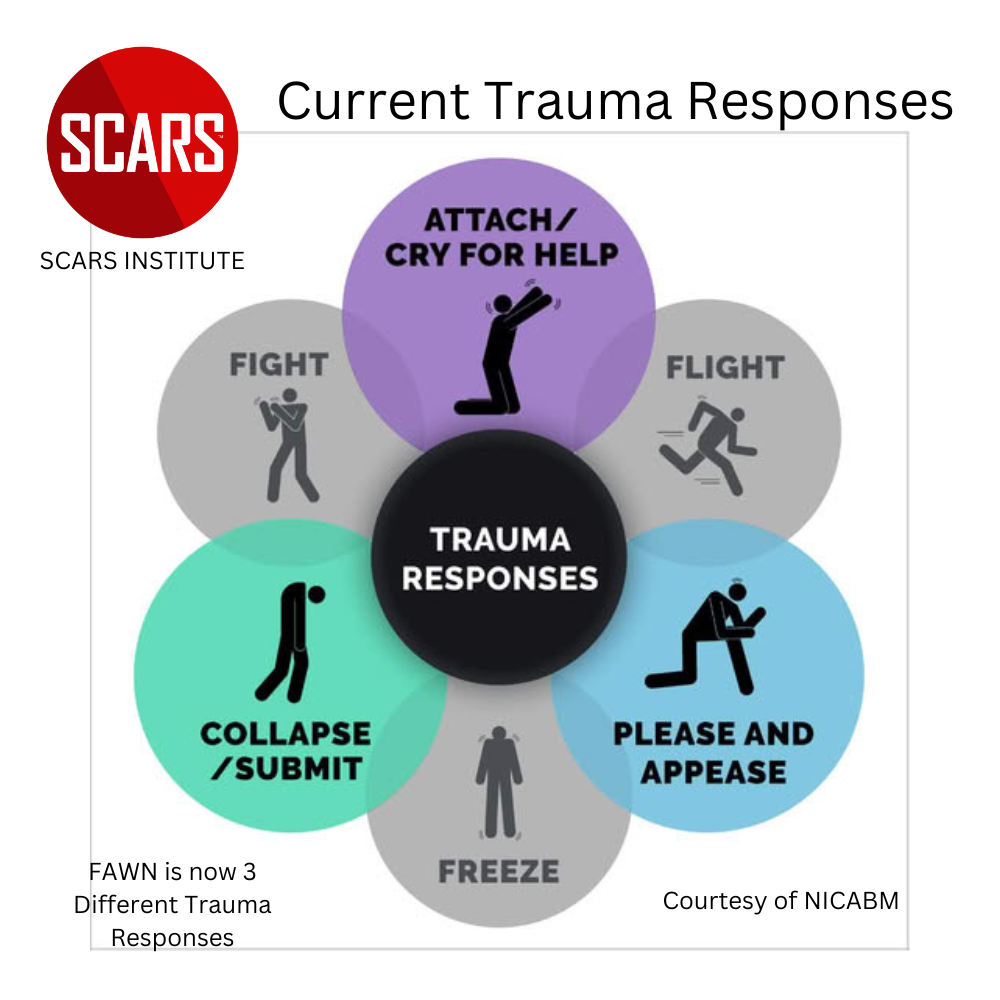Frequent Apologizing and Scam Victims – A Sign of Unresolved Trauma
How Apologizing Becomes a Feature in the Life of Scam Victims After the Scam and Is a Strong Indication of Unresolved Trauma
Primary Category: Scam Victims Recovery Psychology
Intended Audience: Scam Victims-Survivors / Family & Friends
Authors:
• Vianey Gonzalez B.Sc(Psych) – Licensed Psychologist, Specialty in Crime Victim Trauma Therapy, Neuropsychologist, Certified Deception Professional, Psychology Advisory Panel & Director of the Society of Citizens Against Relationship Scams Inc.
• Tim McGuinness, Ph.D., DFin, MCPO, MAnth – Anthropologist, Scientist, Polymath, Director of the Society of Citizens Against Relationship Scams Inc.
About This Article
After experiencing a scam, victims often fall into a pattern of excessive apologizing due to the internalized shame, guilt, and fear of judgment they carry. This behavior, known as the “fawning” trauma response, serves as a coping mechanism to manage feelings of powerlessness, regain a sense of control, and mitigate further conflict or criticism from others.
Apologizing becomes a reflexive action to rebuild trust, express remorse for perceived personal failures, and avoid rejection, even though the scam was not their fault. This can lead to a cycle of low self-worth, difficulty setting boundaries, and strained relationships. However, through therapy, self-awareness, and learning to communicate assertively rather than apologetically, victims can work towards overcoming this response and rebuilding their confidence and self-esteem.

How Apologizing Becomes a Feature in the Life of Scam Victims After the Scam and Is a Strong Indication of Unresolved Trauma
For many scam victims, excessive apologizing becomes a pervasive behavior in the aftermath of their experience. This tendency stems from a complex interplay of psychological and emotional responses to the trauma of being deceived. The act of apologizing often becomes a reflexive tool for navigating the deep shame, guilt, and fear of judgment that victims frequently endure, even though the scam itself was not their fault.
Why Scam Victims Apologize Excessively
Internalized Shame and Guilt: Scam victims often blame themselves for falling victim, believing they should have been more cautious or perceptive. This self-blame manifests as chronic shame, leading them to apologize preemptively, even for things beyond their control. They may feel they’ve “let others down,” such as family members or friends, and use apologies as a way to express remorse for perceived failures.
Fear of Judgment or Rejection: After a scam, victims frequently face stigma or blame from others, who may say things like, “How could you have fallen for that?” or “You should have known better.” To avoid further criticism, victims apologize as a way to defuse potential conflict and demonstrate accountability, even if they are not at fault.
A Coping Mechanism for Regaining Control: Apologizing offers a sense of control in situations where the victim feels powerless. After the scam, they may feel they’ve lost control over their decision-making or trust, and saying “I’m sorry” becomes a way to manage relationships and interactions.
A Way to Rebuild Trust: Victims may feel that apologizing is necessary to repair trust with others, especially if their loved ones were affected by the scam (e.g., financial losses impacting the household). Apologies are used as an attempt to reassure others of their accountability and commitment to avoid similar mistakes.
Trauma-Induced Behavior (Fawning Response): As part of the trauma response known as “fawning,” scam victims may adopt people-pleasing behaviors, including excessive apologies, to maintain harmony and avoid perceived threats in their interactions. This behavior is particularly common if the victim has a history of trauma or learns that appeasement is a way to reduce conflict.
How Apologizing Manifests in Everyday Life
Social Interactions: Victims may apologize excessively during conversations, even when they have done nothing wrong, fearing judgment or misunderstanding. Example: Saying, “I’m sorry to bother you” when asking for help or “I’m sorry I didn’t explain that better” during normal discussions.
Family and Relationships: Victims may feel compelled to apologize to loved ones for the consequences of the scam, such as financial strain or emotional stress, even though they were not responsible for the scam itself.
Professional Settings: At work, scam victims may over-apologize for mistakes or minor oversights, reflecting a deeper fear of being perceived as incompetent or untrustworthy.
Self-Talk: Internally, victims may constantly feel the need to justify or apologize to themselves, reinforcing feelings of guilt and shame.
Emotional Impact of Excessive Apologizing
Reinforces Low Self-Worth: Constantly apologizing reinforces the victim’s belief that they are at fault or inadequate, perpetuating a cycle of self-blame.
Erodes Boundaries: Over-apologizing can lead to neglecting personal needs and boundaries, as victims may prioritize others’ emotions or approval over their own well-being.
Strains Relationships: While well-intentioned, excessive apologies can strain relationships by making others uncomfortable or creating a dynamic where the victim’s needs are overlooked.
Fawning Response in the Context of Trauma
Root Cause: Fawning develops as a survival mechanism, often in response to environments where asserting oneself or expressing anger might have led to rejection, punishment, or further harm. For scam victims, the experience of being deceived and feeling judged or blamed by others can amplify feelings of shame, inadequacy, or fear of disapproval.
Behavioral Characteristics: Apologizing excessively, even when it’s unwarranted or unnecessary. Attempting to de-escalate situations or seek validation through submissive behavior. Prioritizing others’ needs and emotions over their own to avoid conflict or criticism.
Psychological Factors: Excessive apologizing stems from internalized shame and the belief that they are inherently at fault. Victims may feel that by apologizing, they can maintain control over how others perceive them, reducing the risk of further judgment or emotional harm.
Why Scam Victims Exhibit This Response
Overview
Shame and Self-Blame: Victims often blame themselves for falling for the scam, even though the fault lies with the scammer. This internalized blame can lead to a reflexive need to apologize.
Judgment from Others: The stigma and external blame from others (e.g., “How could you fall for that?”) reinforce feelings of inadequacy, prompting the victim to preemptively apologize to mitigate further judgment.
Need for Safety: Saying “I’m sorry” is a way to create emotional safety, signaling to others that the victim is not a threat or challenge, thereby avoiding potential conflict.
Psychological Factors
Learned Behavior: Constant apologizing is often a learned response, shaped by environments where self-assertion or mistakes were met with negative consequences (e.g., criticism, punishment, or rejection). Apologizing becomes a way to preempt conflict, seek validation, or maintain harmony.
Low Self-Esteem: Individuals with low self-worth may apologize excessively as they feel undeserving of space, respect, or understanding. They might internalize the belief that they are inherently flawed or burdensome, leading to a reflexive need to apologize.
Fear of Rejection or Conflict: Over-apologizing often stems from fear of being disliked, judged, or abandoned. Apologies serve as a way to manage perceived relational threats and maintain approval.
Hyper-Vigilance: People who are overly alert to the emotional states of others (often due to trauma or difficult interpersonal relationships) may apologize excessively to avoid triggering negative reactions.
People-Pleasing Tendencies: Apologizing frequently can be part of a broader pattern of people-pleasing, where the person prioritizes others’ comfort or approval over their own needs or boundaries.
Cognitive Distortions: Habitual apologizing may catastrophize outcomes, assuming that minor inconveniences will lead to major issues if not addressed with an apology.
Neurological Factors
Trauma and the Stress Response: Over-apologizing can be linked to an overactive amygdala (the brain’s fear center), which perceives social interactions or minor conflicts as threats. The brain’s stress-response system becomes hyper-sensitive, triggering apologetic behavior as a way to mitigate perceived danger.
Conditioned Neural Pathways: Habitual behaviors, like frequent apologies, create neural pathways that become reinforced over time. The more someone apologizes in response to a perceived issue, the more automatic the behavior becomes. This “apology reflex” can occur without conscious thought, as the brain prioritizes safety over deliberation.
Dopamine and Social Rewards: Apologies may release dopamine when they result in positive feedback or relief from conflict, reinforcing the behavior neurologically. Over time, this reward loop strengthens the habit of apologizing to manage anxiety or gain approval.
Prefrontal Cortex Suppression: In situations of social anxiety or perceived threat, the prefrontal cortex (responsible for rational thinking and self-regulation) may be less active, while the amygdala dominates. This imbalance leads to reactive, rather than thoughtful, responses like over-apologizing.
Mirror Neurons and Empathy: Highly empathetic individuals may have heightened activity in their mirror neuron system, making them more sensitive to others’ emotions. This sensitivity can drive apologetic behavior as a way to align with perceived social expectations.
Why It Happens and Feels Automatic
Subconscious Effort to Gain Control: Saying “sorry” can provide a sense of control in uncertain or uncomfortable situations by attempting to smooth interactions or neutralize potential conflict.
Over-Activation of Social Conditioning: Societal norms, especially those emphasizing politeness or submissiveness in certain roles (e.g., gender expectations), can amplify the habit of apologizing excessively.
Emotional Regulation Tool: Apologies may help the person feel less anxious, as they perceive the act of apologizing as reducing interpersonal tension.
Potential Consequences
-
- Over-apologizing can reinforce feelings of inadequacy or guilt, perpetuating a cycle of low self-worth.
- It may lead to others perceiving the individual as overly submissive, affecting their personal and professional relationships.
- It can erode the apologizer’s boundaries, as they may feel compelled to take responsibility for things beyond their control.
Fawning vs. Please & Appease Trauma Responses
The terms “fawning” and “please and appease” are closely related trauma responses, as both describe behaviors rooted in trauma that aim to avoid conflict, minimize perceived threats, and seek safety. Until recently, Please and Appease was simply considered Fawning. However, they are slightly different in their focus and nuance as we will explain.
Fawning
Definition: Fawning is a trauma response characterized by people-pleasing and submissive behaviors to gain approval, avoid conflict, or mitigate perceived danger. It’s a survival mechanism often developed in response to prolonged exposure to environments where asserting oneself was met with rejection, punishment, or harm.
Key Features: Involves excessive apologies, agreeing with others even when it’s not genuine, or suppressing personal needs to maintain harmony. Driven by a need for emotional or physical safety in relationships. Often subconscious and automatic, a habitual pattern rooted in trauma.
Focus: Primarily about preserving personal safety by pleasing or pacifying others. Aimed at neutralizing a perceived threat from someone else.
Examples:
-
-
- Constantly saying “I’m sorry” to avoid conflict or disapproval.
- Overextending oneself to meet others’ needs at the expense of personal well-being.
-
Please and Appease
Definition: “Please and appease” is a more descriptive phrase often used to explain behaviors that aim to placate others to avoid confrontation or gain favor. It emphasizes deliberate actions taken to calm or satisfy a perceived threat, often by giving in or offering concessions.
Key Features: Involves efforts to calm someone else or preemptively meet their expectations to reduce tension. While it can be trauma-driven, it may also occur in non-trauma contexts where there’s a desire to resolve conflict or maintain harmony.
Focus: Oriented toward defusing or resolving external conflict or tension. Less about internalized safety and more about managing interpersonal dynamics in the moment.
Examples:
-
-
- Offering concessions in an argument, such as saying, “You’re right, let’s do it your way,” to avoid escalation.
- Making peace offerings or taking blame for something that wasn’t your fault to smooth over a situation.
-
Key Differences
Fawning
Scope: Trauma response tied to survival.
Origin: Often stems from childhood trauma or prolonged exposure to unsafe relationships.
Primary Goal: To secure emotional or physical safety for oneself.
Behavioral Traits: Habitual, reflexive, and deeply ingrained.
Focus: Self-preservation by avoiding conflict.
Please and Appease
Scope: Conflict resolution or tension reduction.
Origin: This can occur in any context, including everyday interpersonal conflicts.
Primary Goal: To calm or satisfy another person.
Behavioral Traits: These can be situational and deliberate.
Focus: Reducing external tension in relationships.
Overlap
-
- Both responses involve prioritizing others’ needs or emotions, sometimes to an unhealthy degree.
- Both may involve behaviors like apologizing excessively or suppressing personal desires to maintain peace.
- Both can be counterproductive if they lead to chronic neglect of one’s own needs or boundaries.
While fawning is a trauma-based survival response deeply tied to self-preservation and safety, please and appease is a broader term that describes behaviors aimed at resolving tension, which may or may not be rooted in trauma. Understanding these distinctions helps tailor responses to individuals and contexts, whether addressing trauma recovery or navigating interpersonal dynamics.
The New and Older Trauma Responses
Here’s a quick overview of the differences between the older “Fawn” trauma response and the newer responses:
Fawn Response (Older):
Description: This response involves people-pleasing behaviors to appease or pacify the source of threat or trauma, often at the expense of one’s own needs and boundaries. It develops as a survival strategy to avoid conflict or further harm, particularly in situations of chronic abuse or neglect.
Characteristics: Fawning includes excessive compliance, difficulty setting boundaries, prioritizing others’ needs, and a fear of abandonment or rejection. It’s a form of social engagement to diffuse danger by being agreeable or helpful.
Attach/Cry for Help:
Description: This response is an attempt to elicit help or attention from others, often seen in situations where the individual feels desperate for care or protection. It’s an early survival strategy, particularly in children, aimed at securing safety through attachment to a caregiver or any nearby human.
Characteristics: Involves a sense of desperation, insistent seeking of care, and can appear as a clingy or overly dependent behavior, sometimes with vocal expressions of distress. This response might activate both the sympathetic nervous system (for alertness) and the dorsal vagal system (for seeking help).
Collapse/Submit:
Description: When neither fight, flight, nor freeze are effective or possible, this response leads to a physical or psychological shutdown. It’s akin to playing dead in animal behavior, hoping to be overlooked by a predator or to psychologically escape from overwhelming threat.
Characteristics: Includes numbness, dissociation, an altered state of consciousness, and can lead to feelings of helplessness or hopelessness. There’s a significant drop in energy, sometimes resulting in physical collapse or extreme fatigue. This response is mediated by the dorsal vagal system, indicating a move towards hypoarousal.
Please and Appease (or newer interpretations of Fawn):
Description: Similar to the classic fawn response but highlighted with more nuance in recent discussions around trauma responses. It’s about actively trying to calm or not trigger the source of threat by being overly compliant or engaging in behaviors that make one less of a target.
Characteristics: Involves a strategic use of compliance, attentiveness to the threat’s cues, and might involve going out of one’s way to ensure peace or to avoid triggering the threat’s anger. This can be seen as a more conscious form of fawning.
Each of these responses illustrates the complex ways humans adapt to manage or mitigate traumatic experiences, with significant implications for psychological healing and therapeutic approaches.
How to Address the Trauma Response
Validation
It’s important to understand that being scammed is not your fault, and you have nothing to apologize for. Scammers are skilled manipulators who exploit trust, emotions, and even the most cautious behaviors. Falling victim to their tactics does not reflect a personal failure or inadequacy. You might feel the need to apologize as a way of expressing guilt or shame, but the blame lies entirely with the scammer—not with you. Remind yourself that your worth is not determined by this experience. The harm caused by the scam was the scammer’s deliberate choice, not your mistake. Reaffirming this truth can help you begin to separate your sense of self from the trauma you’ve endured.
Therapeutic Interventions
Seeking professional support can be a powerful way to work through the emotions and habits that have developed after being scammed. Trauma-focused therapies, such as Cognitive Behavioral Therapy (CBT), can help you identify and challenge the patterns of self-blame and over-apologizing that have become automatic. Another effective approach is Eye Movement Desensitization and Reprocessing (EMDR), which can help you process the emotional impact of the scam and reduce the intensity of your trauma response.
In addition to therapy, grounding techniques can help you manage overwhelming feelings in the moment. For example, focusing on your breathing or using the “5-4-3-2-1” method (identifying things you can see, hear, feel, smell, and taste) can bring you back to the present when you feel triggered. These practices can also interrupt the cycle of over-apologizing by helping you pause and consider whether an apology is necessary before speaking.
Encouraging Boundaries
You do not need to apologize for simply existing, having emotions, or asking for help. These are all valid aspects of being human, and no one deserves to feel as though they must constantly justify their presence or needs. Learning to set boundaries is a critical step in reclaiming your confidence and self-worth. Boundaries help you communicate your needs assertively and prioritize your well-being without feeling guilty or responsible for others’ feelings.
Start small by practicing assertive communication in low-stakes situations. For example, instead of saying, “I’m sorry to bother you,” try saying, “Thank you for taking the time to help me.” Over time, replacing apologetic language with confident expressions can reinforce the belief that you are worthy of respect and support. Remember, setting boundaries is not selfish—it’s an essential act of self-care.
Education on Trauma Responses
Understanding why you might feel compelled to over-apologize is an important part of breaking the habit. This behavior is often tied to a trauma response known as “fawning,” where you prioritize pleasing others or avoiding conflict to feel safe. Recognizing this pattern can help you see that your apologies are a learned survival mechanism rather than a reflection of who you are.
By educating yourself about trauma responses, you can begin to notice when fawning behaviors arise and take steps to replace them with healthier alternatives. This self-awareness is empowering—it shows you that your behavior is a response to past experiences, not a flaw or weakness. As you learn more about these patterns, you can give yourself grace and compassion while working to create new, positive habits.
By recognizing excessive apologies as a fawning trauma response, supporters and professionals can provide compassion, understanding, and tools to help scam victims reclaim their sense of self-worth and autonomy.
Addressing these trauma responses takes time, patience, and self-compassion, but each step you take is a move toward reclaiming your voice and your confidence. Remember, you are not defined by the actions of the scammer, and you are worthy of kindness, respect, and healing.
When people habitually say “sorry” for minor or non-existent issues, it reflects a combination of psychological patterns and neurological processes rooted in past experiences, social conditioning, and emotional regulation mechanisms. Here’s an overview of what may be happening:
Breaking the Over-Apologizing Habit
Self-Awareness: Identify triggers for excessive apologies and explore the underlying fears or beliefs driving the behavior.
Reframe Apologies: Replace automatic “sorry” statements with alternative phrases, such as “Thank you for your patience” or “I appreciate your understanding.”
Build Confidence: Practice asserting needs and boundaries in small, low-stakes situations to reinforce self-worth.
Therapeutic Support: Work with a therapist to address trauma, anxiety, or self-esteem issues that may underlie the habit.
Neurological Rewiring: Use mindfulness or cognitive-behavioral techniques to create new neural pathways that prioritize assertiveness over reflexive apologizing.
By addressing both the psychological and neurological factors, individuals can develop healthier communication patterns and reduce the need for excessive apologies.
Tips to Breaking the Cycle of Over-Apologizing
Recognize the Source: Victims can benefit from understanding that their tendency to apologize stems from the trauma of the scam and is not a reflection of their inherent worth.
Reframe Apologies: Replace unnecessary apologies with expressions of gratitude or alternative phrases. For example: Instead of: “I’m sorry for asking this,” try: “Thank you for helping me with this.”
Rebuild Confidence: Focus on reclaiming a sense of agency and self-trust by celebrating small victories and recognizing that falling for a scam does not define their character.
Seek Support: Therapy, particularly trauma-focused modalities, can help victims process feelings of guilt and shame while building healthier coping mechanisms.
Set Boundaries: Practice assertiveness by prioritizing personal needs and expressing thoughts without reflexively apologizing.
Summary
For scam victims, excessive apologizing is often a byproduct of the shame, guilt, and fear of judgment they carry after their experience. While this behavior may initially serve as a coping mechanism, it can reinforce negative self-perceptions and hinder recovery. By understanding the roots of this behavior and actively working to replace it with healthier communication patterns, victims can begin to rebuild their self-worth, reclaim their confidence, and foster more balanced relationships.
When a traumatized scam victim is constantly saying “I’m sorry,” it is often indicative of the “fawning” trauma response. This response is one of the four common trauma reactions (now 6), alongside fight, flight, and freeze. The fawning response involves people-pleasing behaviors aimed at avoiding conflict, gaining approval, or mitigating perceived threats.

Please Rate This Article
Please Leave Us Your Comment Below
Also, tell us of any topics we might have missed.
-/ 30 /-
What do you think about this?
Please share your thoughts in a comment above!
-/ 30 /-
What do you think about this?
Please share your thoughts in a comment above!
ARTICLE RATING
TABLE OF CONTENTS
- How Apologizing Becomes a Feature in the Life of Scam Victims After the Scam and Is a Strong Indication of Unresolved Trauma
- About This Article
- How Apologizing Becomes a Feature in the Life of Scam Victims After the Scam and Is a Strong Indication of Unresolved Trauma
- Why Scam Victims Apologize Excessively
- How Apologizing Manifests in Everyday Life
- Emotional Impact of Excessive Apologizing
- Fawning Response in the Context of Trauma
- Why Scam Victims Exhibit This Response
- Fawning vs. Please & Appease Trauma Responses
- The New and Older Trauma Responses
- How to Address the Trauma Response
- Breaking the Over-Apologizing Habit
- Tips to Breaking the Cycle of Over-Apologizing
- Summary
CATEGORIES
U.S. & Canada Suicide Lifeline 988
![NavyLogo@4x-81[1] Frequent Apologizing and Scam Victims - A Sign of Unresolved Trauma - 2024](https://scamsnow.com/wp-content/uploads/2025/04/NavyLogo@4x-811.png)
ARTICLE META
Important Information for New Scam Victims
- Please visit www.ScamVictimsSupport.org – a SCARS Website for New Scam Victims & Sextortion Victims.
- SCARS Institute now offers its free, safe, and private Scam Survivor’s Support Community at www.SCARScommunity.org – this is not on a social media platform, it is our own safe & secure platform created by the SCARS Institute especially for scam victims & survivors.
- SCARS Institute now offers a free recovery learning program at www.SCARSeducation.org.
- Please visit www.ScamPsychology.org – to more fully understand the psychological concepts involved in scams and scam victim recovery.
If you are looking for local trauma counselors, please visit counseling.AgainstScams.org
If you need to speak with someone now, you can dial 988 or find phone numbers for crisis hotlines all around the world here: www.opencounseling.com/suicide-hotlines
Statement About Victim Blaming
Some of our articles discuss various aspects of victims. This is both about better understanding victims (the science of victimology) and their behaviors and psychology. This helps us to educate victims/survivors about why these crimes happened and not to blame themselves, better develop recovery programs, and help victims avoid scams in the future. At times, this may sound like blaming the victim, but it does not blame scam victims; we are simply explaining the hows and whys of the experience victims have.
These articles, about the Psychology of Scams or Victim Psychology – meaning that all humans have psychological or cognitive characteristics in common that can either be exploited or work against us – help us all to understand the unique challenges victims face before, during, and after scams, fraud, or cybercrimes. These sometimes talk about some of the vulnerabilities the scammers exploit. Victims rarely have control of them or are even aware of them, until something like a scam happens, and then they can learn how their mind works and how to overcome these mechanisms.
Articles like these help victims and others understand these processes and how to help prevent them from being exploited again or to help them recover more easily by understanding their post-scam behaviors. Learn more about the Psychology of Scams at www.ScamPsychology.org
SCARS INSTITUTE RESOURCES:
If You Have Been Victimized By A Scam Or Cybercrime
♦ If you are a victim of scams, go to www.ScamVictimsSupport.org for real knowledge and help
♦ SCARS Institute now offers its free, safe, and private Scam Survivor’s Support Community at www.SCARScommunity.org – this is not on a social media platform, it is our own safe & secure platform created by the SCARS Institute especially for scam victims & survivors.
♦ Enroll in SCARS Scam Survivor’s School now at www.SCARSeducation.org
♦ To report criminals, visit https://reporting.AgainstScams.org – we will NEVER give your data to money recovery companies like some do!
♦ Follow us and find our podcasts, webinars, and helpful videos on YouTube: https://www.youtube.com/@RomancescamsNowcom
♦ Learn about the Psychology of Scams at www.ScamPsychology.org
♦ Dig deeper into the reality of scams, fraud, and cybercrime at www.ScamsNOW.com and www.RomanceScamsNOW.com
♦ Scam Survivor’s Stories: www.ScamSurvivorStories.org
♦ For Scam Victim Advocates visit www.ScamVictimsAdvocates.org
♦ See more scammer photos on www.ScammerPhotos.com
You can also find the SCARS Institute’s knowledge and information on Facebook, Instagram, X, LinkedIn, and TruthSocial
Psychology Disclaimer:
All articles about psychology and the human brain on this website are for information & education only
The information provided in this and other SCARS articles are intended for educational and self-help purposes only and should not be construed as a substitute for professional therapy or counseling.
Note about Mindfulness: Mindfulness practices have the potential to create psychological distress for some individuals. Please consult a mental health professional or experienced meditation instructor for guidance should you encounter difficulties.
While any self-help techniques outlined herein may be beneficial for scam victims seeking to recover from their experience and move towards recovery, it is important to consult with a qualified mental health professional before initiating any course of action. Each individual’s experience and needs are unique, and what works for one person may not be suitable for another.
Additionally, any approach may not be appropriate for individuals with certain pre-existing mental health conditions or trauma histories. It is advisable to seek guidance from a licensed therapist or counselor who can provide personalized support, guidance, and treatment tailored to your specific needs.
If you are experiencing significant distress or emotional difficulties related to a scam or other traumatic event, please consult your doctor or mental health provider for appropriate care and support.
Also read our SCARS Institute Statement about Professional Care for Scam Victims – click here
If you are in crisis, feeling desperate, or in despair, please call 988 or your local crisis hotline.
More ScamsNOW.com Articles
A Question of Trust
At the SCARS Institute, we invite you to do your own research on the topics we speak about and publish. Our team investigates the subject being discussed, especially when it comes to understanding the scam victims-survivors’ experience. You can do Google searches, but in many cases, you will have to wade through scientific papers and studies. However, remember that biases and perspectives matter and influence the outcome. Regardless, we encourage you to explore these topics as thoroughly as you can for your own awareness.























![scars-institute[1] Frequent Apologizing and Scam Victims - A Sign of Unresolved Trauma - 2024](https://scamsnow.com/wp-content/uploads/2025/04/scars-institute1.png)
![niprc1.png1_-150×1501-1[1] Frequent Apologizing and Scam Victims - A Sign of Unresolved Trauma - 2024](https://scamsnow.com/wp-content/uploads/2025/04/niprc1.png1_-150x1501-11.webp)
